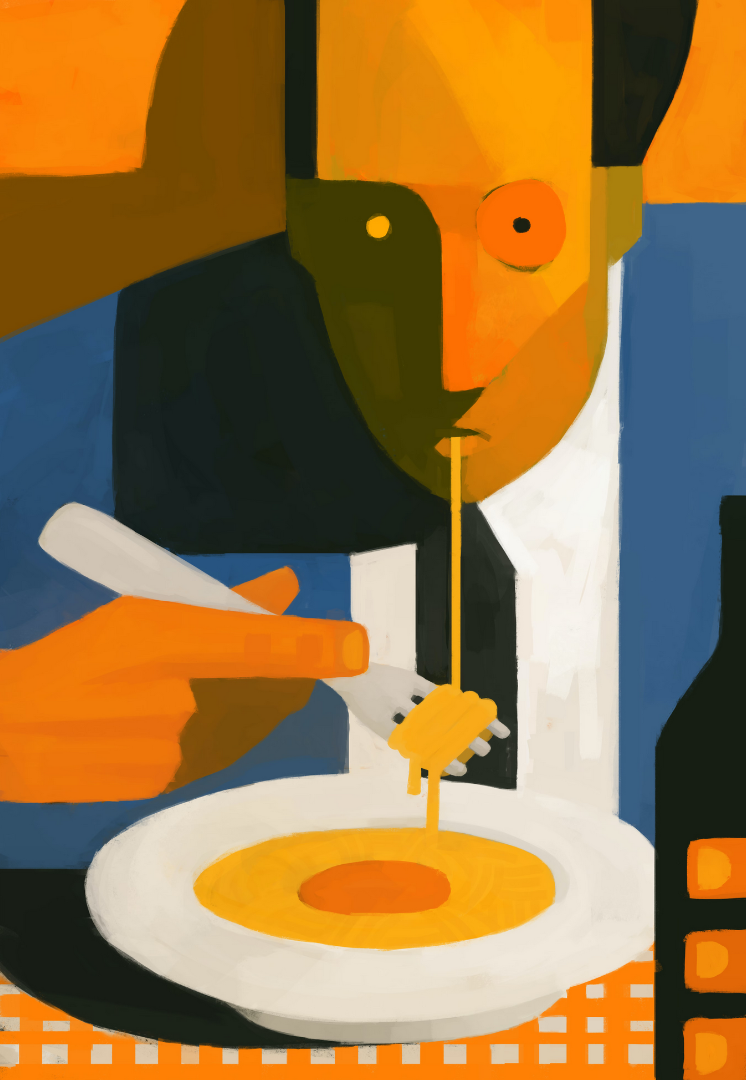IMN #14 — Luca Boni

It's Monday Night #14
Tonight, let’s share thoughts about @artoflucaboni’s digital paintings: a frontal and impudent gaze on the solitude of a set of disconcerting bodies.
I am especially interested in @artoflucaboni's paintings that place a figure on a monochromatic background and take as their subject the singular deformity of a body.
I shall begin by giving my hypothesis.
What @artoflucaboni paints is never a universal body or an ideal body, but any body; it is not any body, it is the sensation that anyone can have of his or her body at any given moment in time: a disturbing, strange, traumatic or grotesque experience.
I see @artoflucaboni's painting as the pictorial appropriation of this anguish of and in the body. It takes this anguish out of the formless, gives it contours, translates it into surfaces and raw volumes of bright colours.
It dislocates classical proportions like a caricature; it resembles a comic strip in its chromatic simplification and extreme contrasted tones; it anonymizes bodies at the same time as it turns them into expressive grimaces.
Each portrait creates a form halfway between a schematization of characters and a monstrous exaggeration of features.
Of course, it looks like a child's style: body parts are incommensurable, colouring seems to have been done with a felt-tip pen, crude shortcuts are used to help the drawing. Like many painters before him, Luca Boni invents his own way of painting in the manner of children.
This pseudo-childish style allows him to make incoherent elements coexist in the subject: realistic skin, whose pigment reddens under the blood flow & garment without texture; a pair of bimbo breasts on an angular & misshapen body; beginning of a drama & pure formal geometry.
Each "scene" is reversible, it is like a double bottomed drawer.
Or rather, there is in each scene a perfect reversibility between the anguish of a being on the brink of an abyss and the comical unfolding of an anecdotal event.
It is a body full of spasms, rictus, sweats, an organic body that secretes a distinct smell and whose stomach gurgles.
In a word, each body is on its way to its own decomposition.
It is both a metaphysical event - the solitary face to face with death - and a physiological one: the life of a body is made up of the forces that resist death within it.
And this resistance has a price: fatigue, even exhaustion, excrements, a more or less disgusting libido.
And yet, the body is, in Luca Boni's painting, a reality that is both brutally organic & subtly erotic.
But it it's no seductive body or icon, it's a body that offers itself with its strangeness, its misalignment with the norms of beauty, youth, health, feminine & masculine.
It is a body that is both radiating vitality and rotting flesh. And it lets himself be seen without the slightest shame, its enormous, naked sex is highlighted in a composition that is neither obscene nor saucy. It takes up a lot of space without taking up all the room.
But that is not all. Every body is also a sign, it is covered with biographical traces: social affiliation, profession, gender, use of recreational substances, etc.
I am fascinated by the mixture of robustness and fragility that emerges, the work on volumes that strangely reconciles the roundness and the angular division of the bodies - there is in each portrait a broken harmony and a grace stained by life itself.
@artoflucaboni works on what makes my body a stranger: a thing that is both my destiny and my salvation, that carries a promise of enjoyment and decrepitude, of feasting and anorexia, of symptoms and physical feats.
@artoflucaboni acknowledges the daily trauma of being/having a body - of having to live in and with a body, of undergoing its metamorphoses and little disturbances, its stiffness and fluids, and all the imaginary life that comes with it.
Each figure is monstrous, but it is a monster that resembles you: the dread that it produces on you and the dread that your own body produces on you insofar as it is never an ideal body and that you would do everything to idealize it.
The portrait becomes a grimace that turns the character's interiority towards the exterior: the symbolism is always undecided - a scene of seduction, anger, exaltation or indifference, the tension is deliberately maintained between several meanings.
There is something of the puppet or the pantomime in these characters who send you back the enigma of their gesture or their posture.
But @artoflucaboni turns this enigma into a grotesque and joyful farce: the indecision of the gesture becomes the scene of a comic misunderstanding, the anguished presence of the body is at the root of all the pictorial jokes that @artoflucaboni tells us.